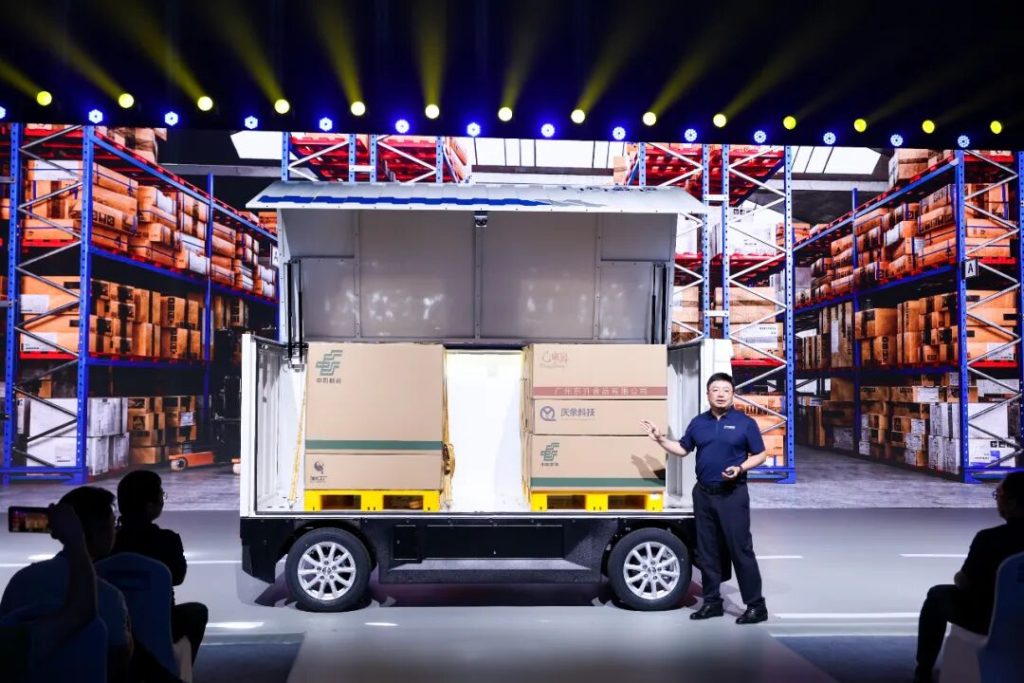
Positive Reviews: The Explosion of Driverless Logistics Vehicles Marks the Deep – water Phase of Autonomous Driving Commercialization
In 2025, driverless logistics vehicles became the focus in the technology and automotive fields as the “Year of Explosion”. This phenomenal breakthrough not only verifies the commercial feasibility of autonomous driving technology in vertical scenarios but also marks that intelligent logistics has entered a new stage of the “technology – driven efficiency revolution”. From the scale of financing, delivery volume, policy support to scenario implementation, the rise of driverless logistics vehicles shows multiple positive meanings.
First of all, the closed – loop verification of the commercialization logic injects confidence into the industry. In the past years, autonomous driving enterprises generally faced the dilemma of “advanced technology but difficult commercialization”. However, driverless logistics vehicles achieved a key breakthrough through the niche scenario of “express transfer”. Jiushi Intelligence adopted the model of “low – cost hardware + software subscription payment” (for example, the Z5 model is priced at 49,800 yuan, and the quarterly software subscription fee is 7,000 yuan), which significantly lowered the threshold for users. Coupled with the financial interest – free plan, the single – event sales record of 5,290 units directly broke the industry deadlock. Leading enterprises such as Neolix and Jiushi delivered more than 10,000 vehicles this year, which is regarded as the critical point of the positive cycle of “technology cost – reduction – scenario verification – scale expansion”. The actual application data of logistics giants such as ZTO Express and SF Express (ZTO has more than 1,800 driverless vehicles, with a cost reduction of 20% – 30%) further prove that driverless logistics vehicles can not only solve the pain points of labor shortage and high costs in last – mile delivery but also create new value through efficiency improvement (reducing intermediate transfer links). This path of “market demand driving technology implementation” provides a replicable commercialization model for the autonomous driving industry.
Secondly, the industrial synergy effect accelerates technology spill – over and ecosystem construction. The participation of traditional intelligent driving suppliers such as Desay SV and Youjia Innovation reflects the industrial upgrading logic of “technology reuse + resource synergy”. As a leading enterprise in the automotive electronics field, Desay SV, relying on nearly 40 years of supply – chain accumulation and an L4 – level autonomous driving algorithm team, migrated the pre – installed mass – production technologies such as intelligent cockpits and sensors to driverless logistics vehicles. This not only reduced the hardware cost (for example, the service life of the full – vehicle – specification power battery increased from 5 years to 6 years/300,000 kilometers) but also improved the product reliability through vehicle – specification standards. This model of “mature main business feeding back new tracks” not only avoids the high risks of start – ups “starting from scratch” but also injects industrial – level stability into driverless logistics vehicles, promoting the industry to leap from “experimental application” to “large – scale commercial use”. In addition, the complementarity between new and old players (start – ups focus on model innovation, and mature enterprises strengthen the technical foundation) is building a more complete industrial ecosystem, laying the foundation for the subsequent expansion of scenarios such as urban distribution and industrial distribution.
Finally, the dual – wheel drive of policy and market provides long – term impetus for the industry. National – level policies clearly support the pilot projects of driverless delivery vehicles, and more than a hundred cities have opened road rights, which solves the core obstacle of “road – going legitimacy” from the top – level design. The rigid demand of the logistics industry (China’s express delivery volume has ranked first in the world for ten consecutive years, and the volume exceeded 120 billion pieces in 2024) provides a huge market space. According to data from Yiou Think Tank, the “transfer – direct – delivery” model with the participation of driverless logistics vehicles can improve logistics efficiency, and each vehicle can save more than 40,000 yuan in costs per year (a cost reduction of 19%). This tangible benefit directly stimulates the purchasing willingness of express delivery enterprises. The resonance between policy relaxation and market demand enables driverless logistics vehicles to quickly transform from a “technological concept” to a “production tool”, and their explosion has a solid real – world foundation.
Negative Reviews: Hidden Worries Behind the Prosperity – Challenges of Scale and Sustainability
Although driverless logistics vehicles had their moment of glory in 2025, their development still faces multiple challenges. If not handled properly, these challenges may restrict the long – term growth of the industry. From fragmented policies to the pressure of technological iteration, from the uncertainty of the competitive landscape to the operational service ability, these issues require high attention from industry participants.
First of all, the non – unified policy standards have become the biggest obstacle to scale. Currently, the access and road – right management of driverless delivery vehicles are still mainly based on local pilot projects (for example, the policies in Beijing, Shanghai, Chongqing and other places vary), lacking a national unified regulatory framework. Experts from China Automotive Engineering Research Institute pointed out that enterprises need national – level standards that are “predictable and normative”. The differences in local policies (such as vehicle certification requirements, road – right scope, and insurance liability definition) directly increase the cost of cross – regional operation. For example, if a driverless logistics vehicle enterprise wants to deploy vehicles in 10 cities, it needs to deal with 10 different sets of access rules respectively, which is a great consumption of resources and energy for start – ups. The fragmentation of policies not only delays the scale – expansion speed but also may cause enterprises to sacrifice technological universality to meet local requirements, affecting long – term technological accumulation.
Secondly, the continuous pressure of technological iteration and cost control tests the resilience of enterprises. Although driverless logistics vehicles have been implemented in the express transfer scenario, their technology still needs to cope with more complex environments (such as bad weather and unexpected road conditions) and more extensive scenarios (such as urban distribution and industrial distribution). In the industrial distribution scenario demonstrated by Desay SV, driverless vehicles need to accurately connect with forklifts and improve space efficiency (28% higher than traditional models), which puts forward higher requirements for perception and decision – making algorithms. In addition, although the “low – cost hardware + software subscription” model lowers the user threshold, the hardware cost (such as vehicle – specification batteries and sensors) still accounts for a large proportion. Enterprises need to further reduce costs through large – scale production and technological optimization. If the speed of technological iteration cannot keep up with the demand for scenario expansion or cost control fails, it may lead to a vicious cycle of “the larger the scale, the more serious the losses”.
Thirdly, the uncertainty of the competitive landscape may lead to homogeneous competition. At present, the market for driverless logistics vehicles is not yet finalized (leading enterprises have only delivered 10,000 vehicles, and the market scale has not been fully opened), attracting various types of players such as start – up companies (Jiushi, Neolix), Internet giants (Meituan, JD.com), and traditional suppliers (Desay SV, Youjia Innovation). Enterprises with different backgrounds have different advantages: start – ups are good at model innovation, traditional suppliers have the ability to reuse technology, and Internet giants have scene resources. However, as more players enter the market, if enterprises fail to find a differentiated positioning (such as Jiushi’s “full – scenario product matrix” and Desay SV’s “vehicle – specification standards”), they may fall into homogeneous competition such as price wars or repeated functions, weakening the overall profit margin of the industry.
Finally, the operational service ability has become the key bottleneck of the software subscription model. The core of the “low – cost hardware + software subscription” model is to bind users through long – term services, but this puts forward higher requirements for the enterprise’s operational ability (such as vehicle maintenance, software upgrade, and data feedback). If an enterprise cannot provide stable technical support (such as untimely response to software failures) or continuous function iteration (such as being unable to optimize algorithms according to user needs), users may choose to terminate the subscription, resulting in the dilemma of “acquiring customers with low – cost hardware but having difficulty in sustaining software revenue”. For example, a driverless vehicle enterprise once had a decline in delivery efficiency due to untimely software upgrades and was finally replaced by traditional manual labor by users. This case warns the industry that business model innovation needs to be supported by strong operational service capabilities.
Advice for Entrepreneurs: Seize the Opportunity of the Explosion Period and Build Sustainable Competitiveness
The explosion of driverless logistics vehicles provides a rare window period for entrepreneurs. To stand out in the competition, they need to focus on the following key strategies:
Anchor on scenarios and deeply cultivate niche demands: Express transfer is the current core scenario, but entrepreneurs should avoid “rushing in blindly” and can choose more vertical niche scenarios (such as supermarket replenishment and industrial park distribution) according to their own resources. For example, Jiushi Intelligence covers the entire urban distribution scenario through the “Z/E/L” series, and Desay SV developed a wing – type model for industrial distribution, which all reflect the importance of “scenario customization”. Entrepreneurs need to conduct in – depth research on the specific needs of the target scenario (such as load capacity, space, and driving route) and develop products that “solve real pain points” instead of pursuing a “large and comprehensive” general – purpose driverless vehicle.
Strengthen technology reuse and continuous R & D: For enterprises with main – business accumulation (such as intelligent driving suppliers), they should make full use of pre – installed mass – production technologies (sensors, algorithms, supply chain) to reduce costs and at the same time maintain continuous investment in L4 – level autonomous driving technology (such as algorithm optimization for complex road conditions). Start – ups need to focus on single – point technology breakthroughs (such as low – cost perception solutions and efficient decision – making algorithms) to avoid the resource consumption of “full – stack self – research”. No matter which path is chosen, technology needs to be deeply integrated with scenarios to ensure the reliability of products in actual operation (such as the extended service life of Desay SV’s vehicle – specification battery).
Flexibly design business models and strengthen service capabilities: The “low – cost hardware + software subscription” is the current mainstream model, but entrepreneurs can design diversified cooperation methods (such as vehicle purchase and transportation capacity leasing) according to customer types (such as express delivery outlets and industrial enterprises). At the same time, they need to establish a complete operational service system (such as 24 – hour fault response, regular software upgrade, and data feedback optimization) to enhance user stickiness through services. For example, they can learn from the “customer success” concept in the SaaS industry and provide customized training and operation guidance for users to ensure that driverless vehicles continuously create value for customers.
Actively participate in policy – making and promote standard unification: Fragmented policies are a common challenge in the industry. Entrepreneurs should actively participate in local pilot projects (such as joining the working group for formulating driverless vehicle access standards) and promote the introduction of national – level regulations through industry associations. For example, they can jointly submit a “White Paper on Road – Right Requirements for Driverless Logistics Vehicles” to regulatory authorities with leading enterprises and logistics customers, feedback policy pain points in actual operation, and help form unified standards for access, insurance, and liability definition to reduce the cost of cross – regional expansion.
Pay attention to long – term ecosystem layout and avoid short – sighted competition: The current market pattern is not yet determined. Entrepreneurs need to avoid getting involved in short – term price wars and focus on ecosystem construction (such as cooperation with logistics enterprises, insurance companies, and charging networks). For example, they can jointly build a collaborative delivery system of “driverless vehicles + couriers” with express delivery companies, develop “special insurance for driverless vehicles” with insurance companies, and cooperate with charging operators to layout special charging networks. Through ecosystem synergy, they can improve overall efficiency and build a competitive barrier that is difficult to replicate.
The explosion of driverless logistics vehicles is not only the result of technological progress but also the combined effect of market demand, policy support, and industrial synergy. For entrepreneurs, to seize the opportunity of the “Year of Explosion”, they need to find a balance in scenario deep – cultivation, technological iteration, model innovation, and ecosystem construction, and run ahead in this new track with sustainable competitiveness.
- Startup Commentary”Building LLMs: The Knowledge Graph Foundation Every AI Project Needs”
- Startup Commentary”The 17th Year of Tmall Double 11 and the New Map Rewritten by AI”
- Startup Commentary”How to Prepare Your Data for Artificial Intelligence”
- Startup Commentary”Small and Medium-sized Banks: “Cutting the Tail” in Loan Assistance”
- Startup Commentary”The Six AI Giants on Stage: AGI Is No Longer a “Future” Thing”




